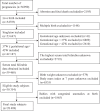Associations between Neonatal Serum Bilirubin and Childhood Obesity in Term Infants
- PMID: 31601856
- PMCID: PMC6787235
- DOI: 10.1038/s41598-019-51043-w
Associations between Neonatal Serum Bilirubin and Childhood Obesity in Term Infants
Abstract
Inverse correlations between serum bilirubin level and obesity had been reported in adults. We aimed to investigate the associations between neonatal hyperbilirubinemia and childhood obesity. Data was obtained from the U.S. Collaborative Perinatal Project (CPP), a multicenter study from 1959 to 1976. Data of serum bilirubin in term newborns were used to observe the association with obesity at age of 7 years. Logistic regression models were performed to calculate adjusted odds ratios (aORs) for obesity. For children from the same mother sharing similar factors, Generalized Estimating Equation (GEE) model was used to correct for intracluster correlation. Relative to newborns with total serum bilirubin (TSB) < 3 mg/dl, there are lower risks for obesity in those with 3 mg/dl ≤ TSB < 6 mg/dl (aOR 0.91; 95%CI 0.81, 1.02), 6 mg/dl ≤ TSB < 9 mg/dl (aOR 0.88; 95%CI 0.78, 0.99), 9 mg/dl ≤ TSB<13 mg/dl (aOR 0.83; 95%CI 0.71, 0.98). By stratifying for subtypes of bilirubin, the inverse correlations only existed in exposure to unconjugated bilirubin. By using the GEE model correcting for intracluster correlations, the results are consistent. In summary, exposure to bilirubin up to 13 mg/dl is inversely associated with obesity at the age of 7 years in term infants.
Conflict of interest statement
The authors declare no competing interests.
Figures
References
-
- World Health Organization. Obesity and overweight. WHO. Available from, http://apps.who.int/gho/dat a/view.main.GLOBAL2480A.
-
- World Health Organization. Obesity and overweight. WHO. Available from, http://apps.who.int/mediacentre/factsheets/fs311/en/.
-
- Singh R. Childhood obesity: an epidemic in waiting? Int J Med Public Health. 2013;3:2–8. doi: 10.4103/2230-8598.109298. - DOI
-
- Susan K. Obesity Accounts for 21 Percent of U.S. Health Care Costs. Cornell Chronicle. http://news.cornell.edu/stories/2012/04/obesity-accounts-21-percent- medical- care-costs.
Publication types
MeSH terms
Substances
LinkOut - more resources
Full Text Sources
Medical


